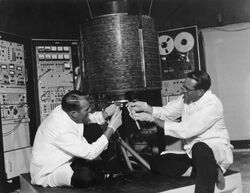Stats[]
| Category. | Statistic. |
|---|---|
| Launch vehicle. | Thrust Augmented Delta (Delta D). |
| Launch date. | April 6, 1965, 23:47:50 UTC. |
| Launch site. | Cape Canaveral LC-17A. |
| Ceased operations. | January 1969 (officially) and January 1990 (unofficially). |
| Owner(s). | International Telecommunications Satellite Consortium (INTELSAT) / Communications Satellite Corporation / Intelsat Corp / INTELSAT. |
| Major contractor(s). | Hughes Aircraft. |
| Is it still in orbit. | Yes as of 2015. |
| Launch mass. | 49.0 kilograms (328.5 lb). |
| Nationality(s). | American. |
| Satellite type. | Communications. |
| Links. | http://www.astronautix.com/craft/intlsat1.htm, http://www.intelsat.com/about-us/our-history/1960-2/, http://nssdc.gsfc.nasa.gov/nmc/spacecraftDisplay.do?id=1965-028A, http://www.britannica.com/topic/Intelsat-I, http://space.skyrocket.de/doc_sdat/intelsat-1.htm, https://en.wikipedia.org/wiki/Intelsat_I and http://rammb.cira.colostate.edu/dev/hillger/EarlyBird.htm. |
History[]

Engineers Stanley R. Peterson (left) and Ray Bowerman (right), checkout the Early Bird, the world's first communication satellite. NASA launched the satellite built by Hughes Aircraft Corporation on April 6, 1965 at 6:48pm E.S.T. from Complex 17a at Cape Kennedy, Florida. Early Bird was built for the Communications Satellite Corporation and weighed about 85 pounds after being placed in a synchronous orbit of 22,300 miles above the earth. It was positioned over the Atlantic to provide 240 two-way telephone channels or 2-way television between Europe and North America. The outer surface of Early Bird was covered with 6,000 silicon-coated solar cells, which absorbed the sun's rays to provide power to the satellite for its intricate transmitting and receiving equipment.

Intelsat I -- "Early Bird" Communications Satellite
Intelsat I (nicknamed "Early Bird") was the first commercial communications satellite to be placed in geosynchronous orbit, on April 6, 1965. It was built by the Space and Communications Group of Hughes Aircraft Company (later Hughes Space and Communications Company, and now Boeing Satellite Systems) for COMSAT. It was based on the satellite that Hughes had built for NASA to demonstrate that communications via synchronous-orbit satellite were feasible. Its booster was a Thrust Augmented Delta (Delta D). It helped provide the first live TV coverage of a spacecraft splashdown, that of Gemini 6 in December 1965. Originally slated to operate for 18 months, Early Bird was in active service for four years, being deactivated in January 1969, although it was briefly activated in June of that year to serve the Apollo 11 flight when the Atlantic Intelsat satellite failed. It was deactivated again in August 1969 and has been inactive since that time (except for a brief reactivation in 1990 to commemorate its 25th launch anniversary), although it remains in orbit. The Early Bird satellite was the first to provide direct and nearly instantaneous contact between Europe and North America, handling television, telephone, and telefacsimile transmissions.
Intelsat I (nicknamed 'Early Bird' for the proverb "The early bird catches the worm") was the first commercial communications satellite to be placed in geosynchronous orbit, on April 6, 1965.
It helped provide the first live TV coverage of a spacecraft splashdown, that of Gemini 6 in December 1965. Originally slated to operate for 18 months, Early Bird was in active service for four years, being deactivated in January 1969, although it was briefly activated in June of that year to serve the Apollo 11 flight when the Atlantic Intelsat satellite failed. It was deactivated again in August 1969 and has been inactive since that time (except for a brief reactivation in 1990 to commemorate its 25th launch anniversary), although it remains in orbit.
Early Bird was one of the satellites used in the then record-breaking broadcast of Our World